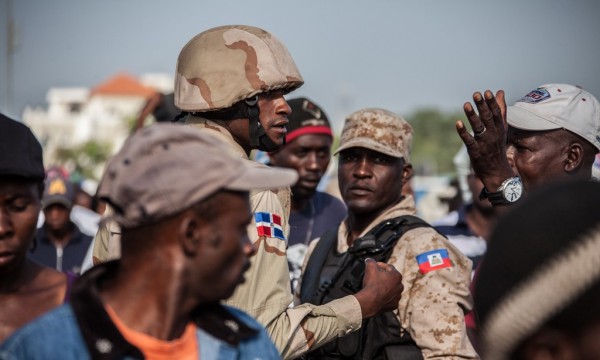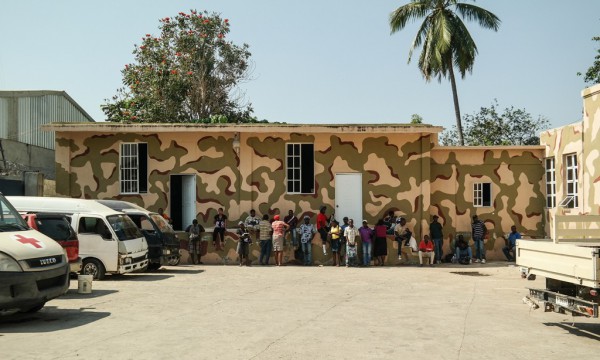Security: a permanent challenge
The security agencies have to face immigration, contraband, human trafficking and crime in the vulnerable frontier region
It is nighttime on the grounds of the "Batalla Sabana Larga" military installation of the Specialize Corps of Frontier Security (Cesfront) in Dajabon. Several Haitians are waiting with their baggage to return to their country, after being picked up without documents in the Dominican Republic.
The next day, a Friday, market day on the frontier, other groups of immigrants arrive at the installations in hope of having better luck. Near here, in the offices of the Directorate General of Migration, a truck arrives in midmorning in the middle of the turbulent frontier market. From the truck dozens of Haitians get off, including mothers with children in their arms. They are more deportees.
In the last four years, Cesfront has returned, through the gates of Dajabon, Elias Piña, Independencia and Pedernales, more than 183,000 foreigners, 99% Haitian. The rest of been 42 Cubans, two Nigerians, one German, one Italian, one Jordanian, six Chinese, one Guatemalan, two Colombians, two Canadians, one Ukrainian, two from Camerun, one Russian, one Spaniard, two Americans and three from Nepal.
The 380 km of the frontier do not have a continual military presence. There are "free" zones, where the Haitians cross to work in Dominican territory, or they are simply uninhabited. The security agencies work focused on points that are identified as vulnerable for use by traffickers and organized crime.
They are supported by some three dozen security cameras, installed at different formal frontier passes, not only to watch over the civilians, but also the military itself.
In places as remote and isolated as the International Highway, there are also forts belonging to the Army of the Dominican Republic, whose personnel is isolated from any urban movements.
The Army talks about, among its achievements on the frontier, the arrest of Clifford Brandt, who escaped in 2014 from a jail in Haiti. They reveal that in that country the man they arrested was serving a sentence for the kidnapping of businessmen and dignitaries.
In spite of the vigilance, trafficking of persons does occur, supported by members of the Army who fall into corruption. An undocumented Haitian who lives in the Dominican capital crossed over in January to his country. In order to return, he contacted a Dominican who has for years been organizing illegal crossings of undocumented persons.
On the day selected, he left his town of Arcahaje (in the west of Haiti), and traveled more than two hours to Elias Piña, where the trafficker was waiting for him. He paid RD$6000. The Dominican took part of it for himself, and the rest he distributed in different amounts to the military personnel that stopped him at the different checkpoints. The most expensive "toll" was that paid at the "15 of Azua": RD$1000. The service of the trafficker was up to that point, and the immigrant took a bus to reach Santo Domingo.
The whole trip was done on a motorcycle. "Everybody could see you, weren't you afraid that they would stop you?", the Diario Libre reporters asked the Haitian. "When things are hard, he himself (the trafficker) gets on the motorcycle (in order to pay the bribes), but when things are cooler, he pays the bus driver, and from there to here the driver continues paying at the checkpoints," he answered.
The government is sticking to the 17 June deadline to register in the National Plan of Normalization of Foreigners. The authorities say that whoever has not registered in this program, is susceptible to repatriation.
The Army indicates that by disposition of the Ministry of Defense, the institution has projected the incorporation of approximately 1700 men in the joint operations which they will be carrying out in support of the Directorate General of Migration, after the end of the Plan.
The military agencies participated this month in a seminar on human rights with regard to this process. "We have proceeded to provide these units with equipment of the latest generation and leading-edge technology, such as thermal vision goggles, to be used on those patrols and watches in which there are conditions of poor visibility," says the Army in a communiqué delivered to this newspaper.

Beyond migration
Besides the National Police, as a law enforcement agency, the Cesfront and the Army provide services in the five frontier provinces, which for the population census of 2010, had a total of 320,767 inhabitants.
The Attorney General of the Republic shows that between 2011 and February 2015 in Montecristi, Dajabon, Elias Piña, Independencia and Pedernales, there were 279 homicides, which represented 3.1% of those that occurred at the national level during this period. Montecristi was the province with the most; 92 were registered, 32.9%.
Cesfront has 15 bases and camps. The personnel of this joint force currently number 1056 members who watch over the kilometers of the frontier line, and up to 15 km inside Dominican territory. They receive incentives, depending on their ranks, which go from RD$6000 to RD$33,000, indicates their director, General Carlos Manuel Aguirre Reyes.
Besides immigration and homicides, the security personnel have to deal with contraband which filters through the frontier. Between 2012 and the beginning of 2015, Cesfront seized thousands of bags and boxes with garlic, sugar, bouillon cubes, condoms, medications and other products.
They also seized 73,045 bottles of alcoholic beverages, more than 11.5 million cigarettes, different varieties of drugs - including marijuana, crack and cocaine - and firearms, among other merchandise.
The other special mission of the military: to repopulate the frontier
Precioso Vallejo worked in a lottery betting office in Elias Piña. He heard that the military were recruiting personnel to go and live in different parts of the frontier in order to repopulate them with Dominicans, and work in farming projects.
He decided to apply, and was accepted. He left his three children in the town, being cared for by a relative, so that they could continue their schooling, and he marched off to live with his wife in Los Cacaos, on the International Highway. "They told me that they were going to give one a house in order to live with your family," he recalls.
At 31, Vallejo is a private in the National Army, a rank whose salary is RD $6118. The program for which he applied gives them an incentive of an additional RD $5000, and the same amount goes to his wife. Now he lives surrounded by rabbits, chickens and fish. Now he forms a part of one of the three "Frontier farm, fish and forest production units," of the Ministry of Defense.
The other two are in the same province. The first was inaugurated in 2011 at Macasias, in the municipality of Comendador, where there are 11 families living. In Guaroa, in the municipality of Banica is the second, with five families.
These are part of a goal, in the first phase, of 18 units along the 380 km of the frontier: one in Montecristi, five in Dajabon, seven in Elias Piña, three in Independencia and two and Pedernales.
Colonel Erick Reyes, the director general of Promotion of Frontier Communities, explains that these projects are trying to promote animal husbandry for subsistence and for sale, and the production of greenhouses of fruits and for the reforestation programs. "As these projects become sustainable and feasible, the plan is that this will generate employment, and this will in turn cause people not to have to leave here; the fact that we now have a school nearby already avoids that the people will leave," he says.
By comparing the data of the last two population census carried out in 2002 and 2010, it can be seen that Dominican inhabitants in the frontier provinces fell by 17,375 in eight years, while the population of foreigners during the same period increased by 29,163.
As of today, the commitment to repopulate the area has not been achieved, since they are at a stage of preparation of the projects, and of determining which are the most feasible and productive areas.
Each unit has a cost of up to RD$40 million. Although the creation of the 18 projects is not going as fast as it was programmed, because of budgetary circumstances, the goal is that they will be established at a rate of three per year.
The direct beneficiaries will be composed of 180 families to be settled, with an average of five members each, a total of 900 direct beneficiaries. Indirectly they will train 1080 persons in different areas of food and forest production, among which they will include Haitians.


 Diario Libre
Diario Libre
 Diario Libre
Diario Libre